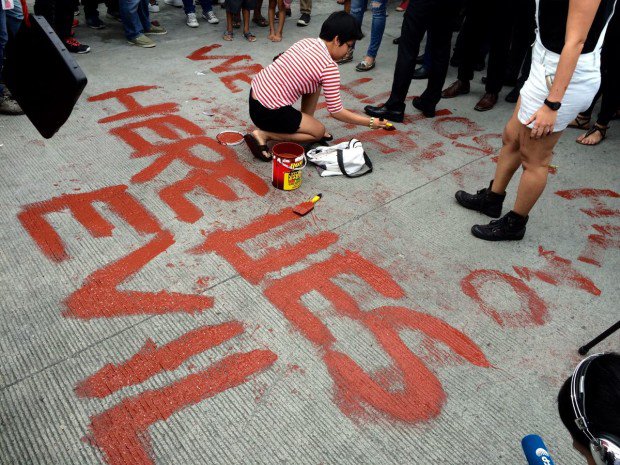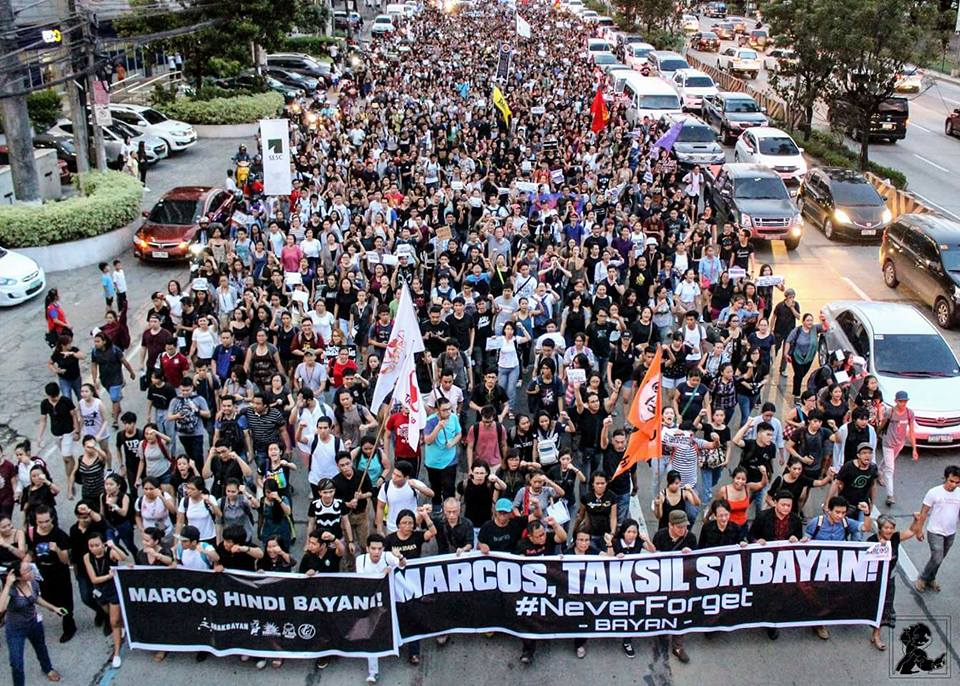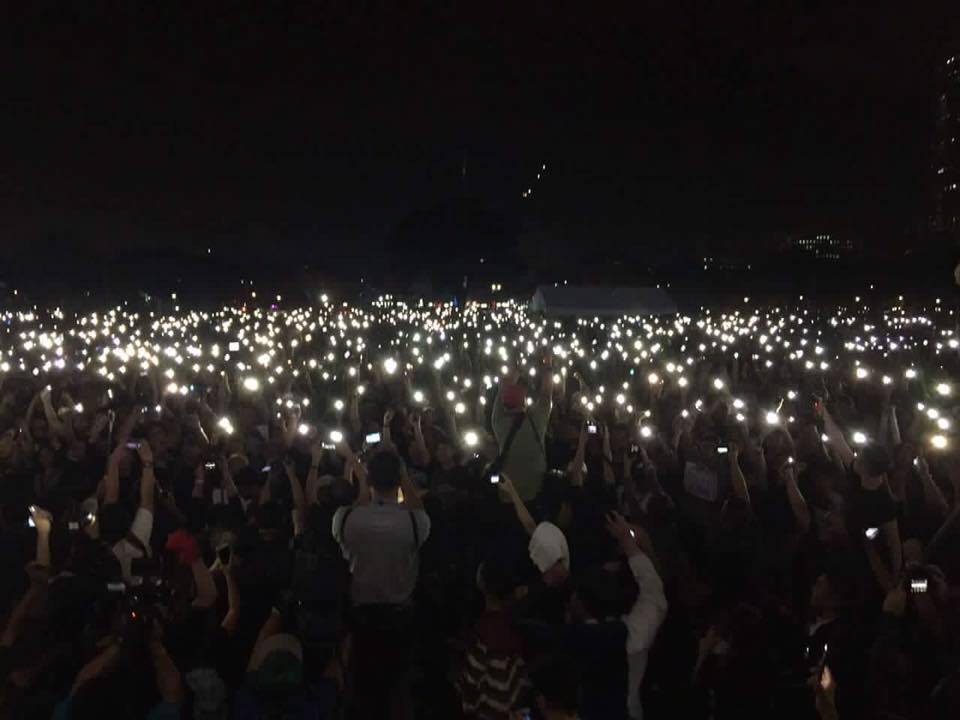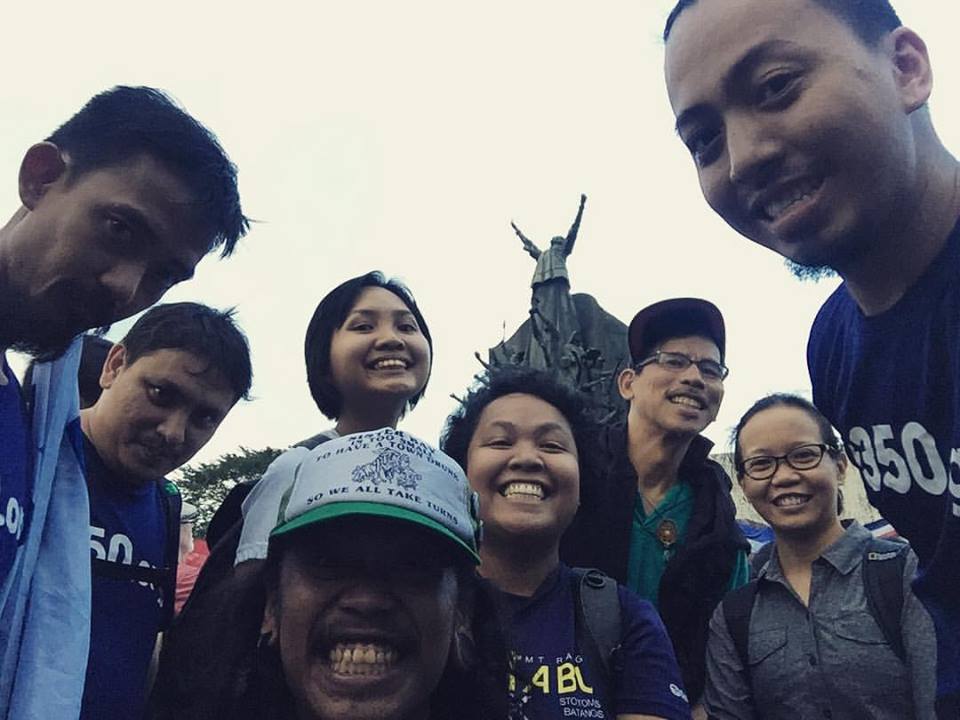By Chuck Baclagon
By the time I went to bed last November 18, I was exhausted.
That morning, I was marching in Makati City with 350.org volunteers and other climate activists dressed as coal spectres haunting countries like the Philippines. We were about to storm the Dusit Hotel, which was hosting the fifth Coaltrans conference, when we got the news that the late dictator Ferdinand Marcos was about to be buried at the Libingan ng mga Bayani (Heroes’ Cemetery). The ceremony was kept hush-hush to avoid protest actions from those opposing Marcos’s burial.

Activists from #BlockMarcos paints “Here lies evil,” just 200 meters away from the gates of the Libingan ng mga Bayani. Photo by Lyn Rillon/INQUIRER
By noon, we were hearing voices of friends on national radio and on social media announcing they were on their way to the Libingan in a last-ditch effort to confront the interment. They were met with a phalanx of police, soldiers and Marcos loyalists gathered outside of the cemetery, causing them to paint the words “Here Lies Evil” on the road adjacent to the memorial’s entrance.

Students from the University of the Philippines, Ateneo De Manila, Miriam College march together along Katipunan Avenue after a joint campus walkout was held in protest of Marcos’ burial last November 18. Photo: Campaign Against the Return of the Marcoses to Malacañang – Carmma
The action was quickly followed by mobilizations, school walkouts and marches throughout the next hours, all converging at the People Power Monument. We joined the crowd after our anti-coal protest, and witnessed the crowd swell to several thousands by midnight. This was followed by pockets of protests throughout the next week and a rally of around 20,000 people in Luneta Park last November 25.

Mobile devices from the 20,000-strong Black Friday Protests against Marcos’ burial lit up Rizal Park last Nov. 25. Photo: Tine Sabillo
We in the climate movement are reminded that as we fight the spectre of dirty energy, we are forced to confront at the same time the spectre of historical revisionism that paints dictators like Marcos as a hero. The benevolent leader of the Filipino people, who was said to have fought against the Japanese invaders in World War II, reshaped the nation after his own image, bringing the full grandeur of his New Society upon the ashes of commie-infested archipelago of farmers, fisherfolks, workers and dissident church leaders who stand in the way of what he saw as the good, the true and the beautiful.
Extraction and deforestation
The word plunder best describes Marcos’s legacy, including on the environment, in the sense that many of the problems the movement faces can trace its roots to the development paradigm that he advanced as part of his New Society. His excessive use of the rule of eminent domain seized forests, farmlands, coastlines and ancestral domains in the name of advancing progress, under a development paradigm that made the way for projects that placed profit over people and ecosystems, and have caused widespread ecological destruction whose impacts can still be felt up to now.
After Marcos was elected in 1965, Marcopper Mining was among the first extractive industries he gave the green light to. It started its copper mining operations in 1969 at the Mt. Tapian Ore Deposit in Marinduque Island.
In August 1996, a significant leak was discovered in the pit’s drainage tunnel. The leak caused a fracture which discharged tailings into the Makulapnit-Boac river system. This released over 1.6 million cubic meters of tailings along 27 kilometers of the river and coastal areas. The toxic spill caused flash floods which isolated five villages, with populations of 4,400 people each, along the far side of the Boac river.
One village, Barangay Hinapulan, was buried under six feet of muddy floodwater, causing 400 families to flee to higher grounds. Sources of drinking water were contaminated with toxins. Fish, freshwater shrimp and pigs were killed outright. Helicopters had to fly in food, water and medical supplies to the isolated villages. The inhabitants of 20 of the 60 villages in the province were forced to evacuate.
Cellophil Resources Corporation (CRC), officially formed in May 1973, was quickly awarded by the then Department of Agriculture and Natural Resources (DANR) with a Timber and Pulpwood License Agreement (TPLA) a mere four months later. It covered some almost 100,000 hectares of pine forests in Abra and Kalinga-Apayao. CRC’s owner Herminio Disini, a dummy of Marcos, was given the permit to operate in most of Abra’s total land area; his company cut huge pine trees in the uplands and put up a factory in the lowlands where the logs were to be processed into a special kind of paper for export.
CRC’s sister company the Cellulose Processing Corporation (CPC) was formed in January 1974, and was also quickly awarded two months later with a TPLA also for almost 100,000 hectares of forest land in areas adjacent to the CRC concessions. In just one year, Cellophil (both CRC and CPC) had quietly obtained almost 200,000 hectares of mostly pine forests in Abra, Kalinga-Apayao, Mountain Province, Ilocos Norte and Ilocos Sur, covering some of the most extensive watersheds of Northern Luzon, and affecting an estimated 145,000 inhabitants of the area, mostly indigenous peoples.
It was in opposition to this projects that Catholic priest Nilo Valerio, Resteta Fernandez and Soledad Salvador were killed by government security forces. According to witnesses, the three were beheaded and their heads were displayed in several barrios before being buried in a single grave in 1985.
Moreover, this trend of forest conversion paved the way for massive deforestation that extended throughout the archipelago. It created conditions that led to landslides like the one happened in Ormoc in 1991; Real, Infanta and General Nakar in 2004; and Guinsaugon in 2006.
Bloody dams, nuclear ambitions and fossil-fueled development
In 1974, Marcos tried to implement a 1,000-megawatt hydroelectric power project, to be funded by the World Bank, along the Chico River. The plan called for the construction of four dams that would have put many villages under water, covering an area of around 1,400 square kilometers of rice terraces (payew), orchards, and graveyards. As many as 100,000 people living along the river, including Macliing Dulag’s Bugnay village, would have lost their homes.
It was during this period that indigenous leaders like Macliing, a respected elder of the Butbut tribe, would lead the fight against the Marcos regime’s Chico River Dam Project. He would eventually be murdered by government soldiers on April 24, 1980. His assassination merely solidified opposition to the dam and won it sympathizers from all over the country and even abroad. Even the World Bank, which would have funded the dam construction, withdrew from the project, finally forcing the martial law government to cancel its plans. Today it stands as a landmark case study concerning ancestral domain issues in the Philippines.
Another dirty legacy of the regime is the Bataan Nuclear Power Plant (BNPP), which was built starting in 1976. Following the 1979 Three Mile Island accident in the United States, construction on the BNPP was stopped, and a subsequent safety inquiry into the plant revealed over 4,000 defects. Among the issues raised was that it was built near a major geological fault line and close to the then-dormant Mount Pinatubo.
From an initial estimated cost of US$600 million in 1975, the BNPP incurred a monster loan of US$ 2.3 billion and some US$ 640 million worth of interest payments. The Filipino people continue to pay for the BNPP debts that an “Honor All Debts” policy has created. We have suffered long enough by the costs created by the collusion of the financial institutions, cronies, and a few government officials.
Beyond all these glaring examples, we must remember that it was the Marcos regime which consigned us to fossil fuel dependence and coal-powered development. He was the president who ordered the construction of the Calaca coal plant in Batangas, the first and oldest in the Philippines.
Moving on…

350.org activists join the indignation rally at the People Power Monument last November 18, to protests the secret burial of Marcos at the Libingan ng mga Bayani. Photo: Jikjik Tumbado
Environmental activism is about drawing the line to stand on the side of life for it to exist and thrive in all its diversity.
Our activism demands that we stand up against the burying of the lessons of poor energy choices made by the Marcos dictatorship. It means that we also have to stand against the current resurrection of dirty energy like coal and nuclear, which continue to be peddled by this administration’s energy secretary Alfonso Cusi.
Marcos’s destructive track record of plunder and repression outshines the glitter of the martial law’s golden age. It is hard to reconcile how one leader who pursued this dirty and bloody path to supposed development could ever be declared a hero.
We cannot and will not move on without closure, which can only come when we resolve ourselves to the overwhelming evidence that, in the face of the climate crisis, coal and nuclear have no place in our energy mix.
Never again.
